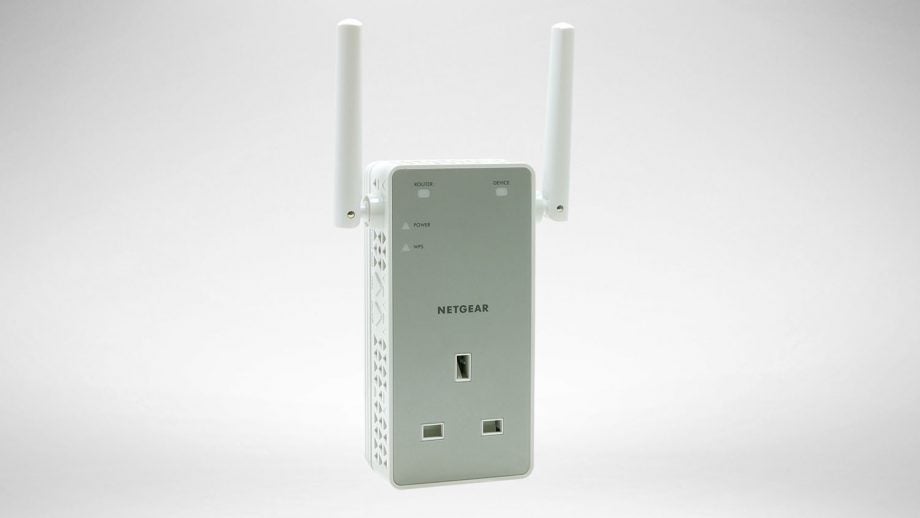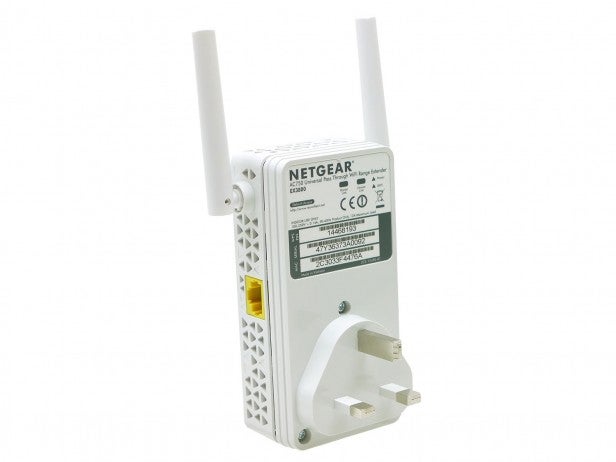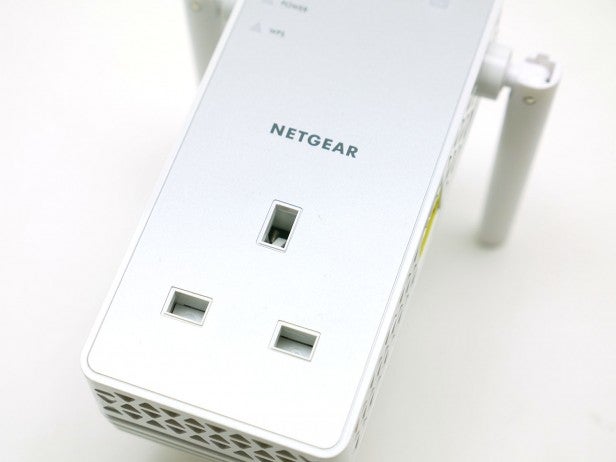Netgear EX3800 Review
Netgear EX3800
A fast and convenient Wi-Fi extender

Verdict
Pros
- Good overall range and speed
- Convenient mains passthrough
- Good value
Cons
- Slightly dull design
- Annoying enforced sign up to Netgear Genie
Key Specifications
- Review Price: £50.00
- Up to N300 and AC750 WiFi speeds
- 1 x Ethernet port
- Passthrough mains power socket
- Power off switch
- WPS, push to connect
- Extend 2.4GHz and 5GHz simultaneously
What is the Netgear EX3800?
The Netgear EX3800 is a mid-range dual-band Wi-Fi extender that can be used to extend the range of your Wi-Fi signal, saving you the hassle of having to run cables throughout your home.
It supports Wi-Fi speeds up to 750Mbps and includes a mains passthrough socket so it doesn’t take up one of your plug sockets.
Netgear EX3800 – Design and Features
The EX3800 isn’t the most stylish bit of kit I’ve ever seen. Its boxy shape, mass of ventilation holes and silver front plate have nowhere near the clean elegance of the Linksys RE6400 AC1200 Boost Ex, for instance.
Nonetheless, it’s a compact device with dimensions of 55x114x34 mm, and the mains passthrough makes its overall footprint much less of a problem.
On the front you get four lights that clearly indicate the status of the extender, with Power, WPS, Router connection and Device Connection showing that it’s up and running and connected to the rest of your network.
Related: Best Wi-Fi Extenders
On the left side is a button for activating WPS for a single-button way to connect to your router. Below this is a power button for turning off the extender, making for a more convenient way to power it down than simply unplugging it. It still functions as a mains passthrough even when switched off, which is handy.
Over on the right is a single Ethernet port that can be used to connect wired devices to your WiFi network. This is great if you have a network printer or desktop PC that doesn’t have Wi-Fi built in, plus it means you’ll get theEX3800’s maximum performance with no loss of speed.
The placement is a bit awkward, though, as it means the network cable shoots off to the side. It would be better for keeping things tidy if it faced straight down.
Netgear EX3800 – Setup
Initial setup of the Netgear EX3800 is straightforward enough. Just plug it in and press the WPS button on the extender then your router. After thirty seconds the two will connect and you’re ready to go.
However, to get both bands of your Wi-Fi connected you’ll have to login to the extender by connecting to its network and navigating to www.mywifiext.net (or typing in its IP address), and it’s here that the experience takes a turn for the worse.
Netgear insists on you signing up for its Netgear Genie service before you can access the Settings page. This is annoying both because you shouldn’t have to do this before setting up the device and because it really isn’t necessary for the EX3800 to work properly.
Genie is only useful you have also happen to have a Netgear router, so having to sign up to a service for what is very much a cross-platform device just seems silly.
Otherwise, though, once through the signup process the settings page is clear and simple and allows you to setup the extender to extend both Wi-Fi bands and change their names and passwords.
Netgear EX3800 – Performance
To test the EX3800 I positioned it around 10m from the router with two brick walls in between. Like with the Linksys RE6400, this was around the point where its link to the router was switching from green to amber, indicating it’s at the edge of its usable range.
Then, using a laptop equipped with an AC1900-capable WiFi adapter, I moved a further 8m or so away from the router and extender. At this range the router alone would occasionally drop connection – particularly using the laptop’s weaker onboard Wi-Fi.

The Netgear EX3800 comfortably proved its worth: without the extender the test router managed 34.5Mbps using 2.4GHz and just 2.8Mbps using 5GHz. This may seem like a strange result given 5GHz is generally considered faster, but while 5GHz can be faster overall, 2.4GHz has greater range.
Using the EX3800’s Wi-Fi I again found that at 2.4GHz the extended signal was actually slower than directly to the router, dropping to 27.1Mbps. This isn’t as dramatic a drop as with the Linksys RE6400 but it’s a further indication of the long range of 2.4GHz Wi-Fi, especially with a powerful multi-aerial router.
However, for 5GHz, the total opposite was true. It leapt to 61.9Mbps, further proving the point about a high maximum speed but shorter range. All told, finding the right sweet spot to place the extender will clearly be a case of trial and error, but if you use the 5GHz band exclusively, it’s a no-brainer.
Regardless, the EX3800 was just outperformed by the higher-specification Linksys that managed to hit 71.4Mbps in the same test.
Should I buy the Netgear EX3800?
The EX3800 is a great option for those looking to stretch their Wi-Fi signal to those hard-to-reach places. It’s easy to setup, delivers decent Wi-Fi speeds and has a useful selection of features – the mains passthrough being a particular highlight.
It’s also competitively priced at around £50. That’s £10 less than the Linksys RE6400, which delivers very similar performance and just £10 more than the BT 11ac Dual-Band Wi-Fi Extender 1200, but the latter lacks the mains passthrough of the Netgear.
The only stumbling block is the annoying insistence on signing up to Netgear Genie, which is totally unnecessary for a device like this. It’s a small gripe but one that some buyers might find irritating.
Buy Now: Netgear EX3800 at Amazon.co.uk from £50
Verdict
A very capable Wi-Fi extender for a great price.

